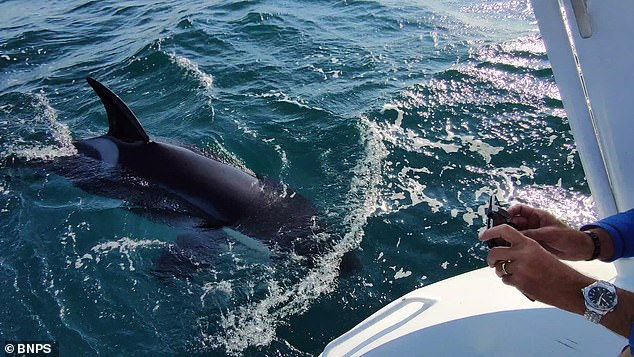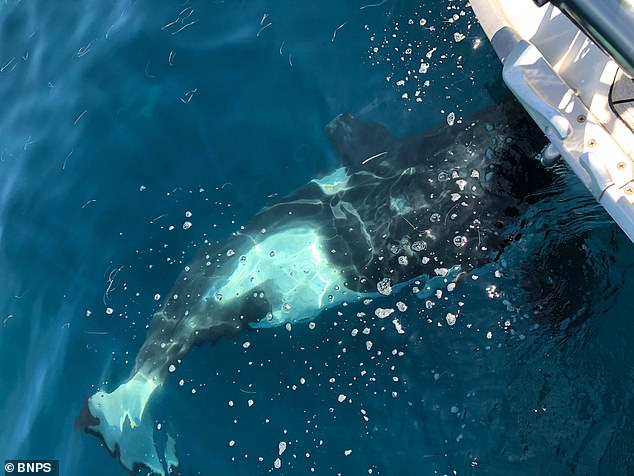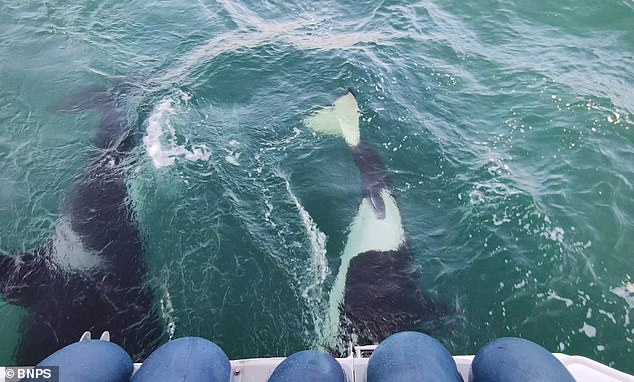Orcas have caused chaos among boaters since 2020, crashing into the rudders of more than 600 boats and causing many to sink.
Marine biologists have now revealed that their seemingly aggressive behavior may actually be simply actions of boredom among these highly intelligent animals.
In a report released Friday, biologists, government officials and other marine representatives said boat rudders make excellent toys for orcas in open water.
Researchers believe the sudden trend of attacking ships began around 2019 after a rapid increase in the killer whales’ main food source, bluefin tuna, thanks to conservation efforts and fishing bans.
This meant that the whales passed less time hunting, which leaves them with a lot of free time.
In a report released Friday, biologists, government officials and other marine representatives said boat rudders make excellent toys for orcas in open water.
Although the reason the attacks began has not been officially confirmed, marine biologists believe they began when an adolescent whale played with the rudder in front of its peers, creating a trend.
“Maybe that individual touched a rudder and felt it was something fun to play with,” said Alex Zerbini, who chairs the scientific committee of the International Whaling Commission. Washington Post.
“And, after playing, it started to spread the behavior among the group until it became as widespread as it is now.”
Orcas have started similar trends in the past, such as wearing dead salmon as hats and playing chicken.
The attacks on the boats were instigated by a group of 15 whales, mostly juveniles and adolescents, aged between five and 18, who approach the boats slowly to supposedly gently push their noses against the rudders.
Marine biologists reported that although adult females were observed in the area at the time of the attack, “they appear to be simply guarding their young, who are the ones really playing,” said Naomi Rose, senior scientist at the Animal Welfare Institute. to The Post.

Researchers believe the trend began when an adolescent whale slammed its nose into a rudder in front of its peers. In the photo: An orca attacking Dieter Peschkes’ yacht off the Iberian Peninsula in 2021

Orcas have started similar trends in the past, such as wearing dead salmon as hats and playing chicken. Pictured: An orca attacking Alan Bruce’s yacht off the Iberian Peninsula in 2021

The report says that orcas are known to play with other objects or animals in the sea, but can fall overboard, in some cases killing the object of their fun. Pictured: Two killer whales attacking Dieter Peschkes’ yacht off the Iberian Peninsula in 2021
Researchers believe their boredom is due to the abundance of food on the Iberian Peninsula, where attacks occurred mainly off the coasts of Portugal, Spain and Morocco.
In 2019, orcas faced food shortages as the population of their main food source, bluefin tuna, declined, forcing them to spend most of their time hunting and eating whatever food they could find.
But after the bluefin tuna population recovered the following year, the whales no longer needed to spend all their time hunting for food, leaving them with nothing to do.
“The sea is a very boring place for an animal,” said Renaud de Stephanis, president of CIRCE (Conservation, Information and Research on Cetaceans), an organization dedicated to preserving marine life. USA Today.
‘Imagine if you are a dog or some other mammal., you can interact with the objects around you. But in the sea, orcas don’t have much to interact with, so they play with the rudders,” he said.
He report He said orcas are known to play with other objects or animals in the sea, but they can fall overboard, in some cases killing the object of their fun.
‘…In the salmon-eating population of resident killer whales in southern Washington, USA, individuals ‘play’ with the porpoises to the point of killing them, which may be a similar escalation of a initially less harmful interaction,’ the report said, adding: “So this behavior appears to be on that spectrum.”
The researchers warned sailors against launching flares and other devices to scare the whales, saying this could make the game more fun for them.
Instead, they suggest making rudders less fun for orcas or, if possible, removing them altogether.
The group is working on alternative methods to replace the smooth surfaces of rudders with rough or abrasive materials and devices that will produce loud noises, such as banging, to deter whales from approaching.
In the report, marine biologists also advised boaters to travel around orca hotspots to mitigate an attack before it occurs, with the caveat that whales are constantly migrating, so predicting where they will be is not 100 percent. successful cent.
“We don’t want to see any more sunken ships and we don’t want to see people in danger,” Zerbini told the Post.
‘But we don’t want the animals to be hurt either. And we have to remember that this is their habitat and that we are on the path.”
Since ships were advised to flee any potential interaction with whales in May last year, the number of attacks has fallen by 70 per cent.

